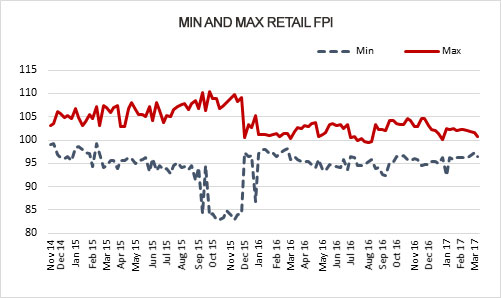Indexes
 04
March
2017
04
March
2017

 04
March
2017
04
March
2017
Retail food prices in Tbilisi supermarkets increased by 1.4% m/m (that is, compared to the middle of February) and 3.8% y/y (that is, compared to March of 2016). On a biweekly basis, the biggest price increases happened for eggplants, onions, and rice (price increased by 34.3%, 21.7%, and 19.2%, respectively). As to the biggest drops in prices, cucumbers, buckwheat, and vegetable oil experienced the most significant price decreases (31.8%, 12.4%, and 3.1% respectively).
Although worldwide food prices have been steadily decreasing over the last couple of years, food prices in Georgia have increased y/y. This increase was captured both by the National Statistics Office of Georgia (Geostat) and ISET’s Retail FPI. According to Geostat’s latest report on inflation, food price inflation in Georgia in February reached 5.5% y/y (that is, compared to the last year’s February). For Tbilisi, it was even higher and reached 5.8% y/y.

ISET’s Retail FPI, which looks at supermarkets only, also shows an increase in food prices. However, it is a bit smaller (2.0% in February and 3.8% y/y in March). One possible explanation for the smaller increase can be heightened competition among food retailers (supermarkets) in Tbilisi. The number of such retailers has clearly increased over the years. From 2014 until today, Nikora has increased the number of its branches from 92 to 106, the number of SMART supermarkets expanded from 10 to 16, Furshet grew from two to eight stores, and Carrefour has gradually increased its outlets to six. Other retailers like Fresco and Spar have also expanded their branch numbers.
Not only have existing food chains increased the number of their branches, but some new retailers have emerged in the food market as well. AgroHub is the latest addition to the retail food market in Georgia. AgroHub promotes itself as the first hypermarket of Georgian food products and is offering consumers the unique experience of not only buying food but trying it while shopping, as well. Moreover, most products sold in this hypermarket are produced by the farms and food processing factories owned by AgroHub itself.
One can argue that a high level of competition leads to price convergence among supermarkets, which according to the diagram happened mostly after 2016. The price range (difference between the maximum and minimum retail FPI) shrinks as more supermarkets enter the market. Hopefully, this trend will continue, and the Georgian food retail market will become more diversified and combine large supermarkets with traditional small shops.





